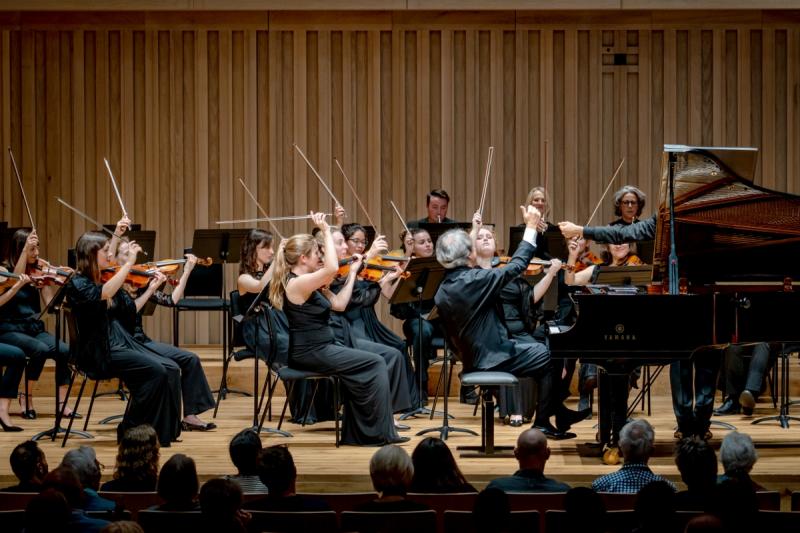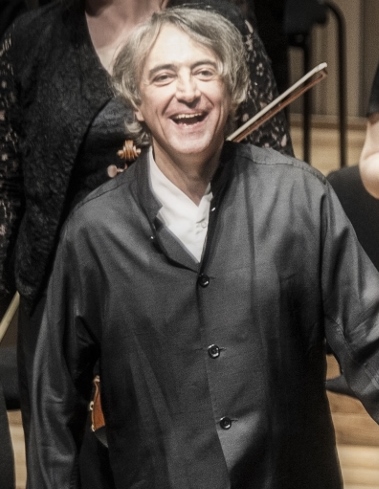Bavouzet, Manchester Camerata, Takács-Nagy, Stoller Hall, Manchester review - spirit of the 1780s | reviews, news & interviews
Bavouzet, Manchester Camerata, Takács-Nagy, Stoller Hall, Manchester review - spirit of the 1780s
Bavouzet, Manchester Camerata, Takács-Nagy, Stoller Hall, Manchester review - spirit of the 1780s
Historically informed playing and a delight to hear

It was very much the formula as before, as Jean-Efflam Bavouzet and Gábor Takács-Nagy moved their edition of the Mozart piano concertos a step closer to completion with Nos. 11, 12 and 13.
That formula has served them well in the past: it’s not “authentic” – Bavouzet plays a Yamaha grand, after all, and the musicians of Manchester Camerata play on modern instruments – but it’s certainly historically informed, as well as a delight to listen to.
Their Chandos recordings of this “Mozart, made in Manchester” set are popping out steadily and earning high praise, and on this occasion, tackling the three concertos that were written to stake Mozart’s claim to attention in Vienna soon after he arrived there, the spirit of the age (the early 1780s) was almost tangible. The delicate illuminations of “sensibility” were still very much a watchword in musical expression, but the early rays of rich Romantic sunlight were also beginning to dawn.
And you could also enjoy genteel jollification on some occasions, one such being the debut of the Singspiel The Abduction from the Seraglio (in 1782), whose overture was the hors d’oeuvre to this three-course menu. The Mozart-Manchester project includes recording all the Mozart opera overtures as well as the piano concertos, and this one began Saturday’s concert, complete with triangle, cymbals and Jingling Johnnie to create the true “Turkish music” noise. Gábor Takács-Nagy found more in it than just sound effects, though, with a pleasant skipping tempo for its main theme and neatly controlled string and oboe articulation.
The complete Abduction may have contained “an awful lot of music”, in the view of enlightened Emperor Joseph the Second, but we know he deigned to listen to at least one of the three piano concertos of this set twice over, so it must have done some good.
The first of them, K413 or No. 11, is one on its own in having both outer movements in triple time, but the dancing pulse and delicious hesitations brought to its first movement by Takács-Nagy, echoed by Bavouzet, were immediately appealing, while the tenderness of the slow movement and its sorrowful appoggiature tugged at the heartstrings. The finale sounds like a Minuet, and conductor and soloist made nicely pointed contrasts between the laid-back, almost naïve main theme and its lively episodes. Bavouzet’s playing of the cadenzas was both virtuosic and animated by proto-Romantic feeling.
 K414, or No. 12, is known particularly for its slow movement, which quotes almost precisely a theme by Johann Christian (the “London”) Bach, Mozart’s exemplar and inspiration in his earlier years, who had died not long before the concerto was written. In truth the movement sounds like an hommage, not a memorial nor yet a pastiche, with its elegiacally undulating string figuration, and Bavouzet (pictured left) brought a feeling almost of impromptu to its lead-in to the theme’s repeat. His playing in the first movement’s Fantasy was dramatic, and the finale likewise caught fire in its last pages. He keeps his use of the sustaining pedal to the very minimum, needing it only to ensure legato in some right-hand melodies in octaves and occasionally to fill out his sound momentarily, so the piano, though obviously having little in common as to timbre with the kind Mozart would have played, reflects his music with enviable purity.
K414, or No. 12, is known particularly for its slow movement, which quotes almost precisely a theme by Johann Christian (the “London”) Bach, Mozart’s exemplar and inspiration in his earlier years, who had died not long before the concerto was written. In truth the movement sounds like an hommage, not a memorial nor yet a pastiche, with its elegiacally undulating string figuration, and Bavouzet (pictured left) brought a feeling almost of impromptu to its lead-in to the theme’s repeat. His playing in the first movement’s Fantasy was dramatic, and the finale likewise caught fire in its last pages. He keeps his use of the sustaining pedal to the very minimum, needing it only to ensure legato in some right-hand melodies in octaves and occasionally to fill out his sound momentarily, so the piano, though obviously having little in common as to timbre with the kind Mozart would have played, reflects his music with enviable purity.
K 415, or No. 13, is one of those solid C major celebrations that Joseph II probably liked to hear (with trumpets and drums added only on the day of the premiere, the better to salute his Imperial presence, according to Gábor Takács-Nagy’s little speech of explanation to Saturday’s audience). But it has its subtleties, too, both in the singing second subject of the opening movement and in the stately sentiment of the central Andante. Bavouzet, with Mozart’s own cadenzas once again to give his imagination scope and keep him on the right stylistic path, enhanced his role with elegance and apt touches at every point.
rating
Explore topics
Share this article
The future of Arts Journalism
You can stop theartsdesk.com closing!
We urgently need financing to survive. Our fundraising drive has thus far raised £49,000 but we need to reach £100,000 or we will be forced to close. Please contribute here: https://gofund.me/c3f6033d
And if you can forward this information to anyone who might assist, we’d be grateful.

Subscribe to theartsdesk.com
Thank you for continuing to read our work on theartsdesk.com. For unlimited access to every article in its entirety, including our archive of more than 15,000 pieces, we're asking for £5 per month or £40 per year. We feel it's a very good deal, and hope you do too.
To take a subscription now simply click here.
And if you're looking for that extra gift for a friend or family member, why not treat them to a theartsdesk.com gift subscription?
more Classical music
 Robin Holloway: Music's Odyssey review - lessons in composition
Broad and idiosyncratic survey of classical music is insightful but slightly indigestible
Robin Holloway: Music's Odyssey review - lessons in composition
Broad and idiosyncratic survey of classical music is insightful but slightly indigestible
 Classical CDs: Wolf-pelts, clowns and social realism
British ballet scores, 19th century cello works and contemporary piano etudes
Classical CDs: Wolf-pelts, clowns and social realism
British ballet scores, 19th century cello works and contemporary piano etudes
 Bizet in 150th anniversary year: rich and rare French offerings from Palazzetto Bru Zane
Specialists in French romantic music unveil a treasure trove both live and on disc
Bizet in 150th anniversary year: rich and rare French offerings from Palazzetto Bru Zane
Specialists in French romantic music unveil a treasure trove both live and on disc
 Scottish Chamber Orchestra, Ibragimova, Queen’s Hall, Edinburgh review - rarities, novelties and drumrolls
A pity the SCO didn't pick a better showcase for a shining guest artist
Scottish Chamber Orchestra, Ibragimova, Queen’s Hall, Edinburgh review - rarities, novelties and drumrolls
A pity the SCO didn't pick a better showcase for a shining guest artist
 Kilsby, Parkes, Sinfonia of London, Wilson, Barbican review - string things zing and sing in expert hands
British masterpieces for strings plus other-worldly tenor and horn - and a muscular rarity
Kilsby, Parkes, Sinfonia of London, Wilson, Barbican review - string things zing and sing in expert hands
British masterpieces for strings plus other-worldly tenor and horn - and a muscular rarity
 From Historical to Hip-Hop, Classically Black Music Festival, Kings Place review - a cluster of impressive stars for the future
From quasi-Mozartian elegance to the gritty humour of a kitchen inspection
From Historical to Hip-Hop, Classically Black Music Festival, Kings Place review - a cluster of impressive stars for the future
From quasi-Mozartian elegance to the gritty humour of a kitchen inspection
 Shibe, LSO, Adès, Barbican review - gaudy and glorious new music alongside serene Sibelius
Adès’s passion makes persuasive case for the music he loves, both new and old
Shibe, LSO, Adès, Barbican review - gaudy and glorious new music alongside serene Sibelius
Adès’s passion makes persuasive case for the music he loves, both new and old
 Anja Mittermüller, Richard Fu, Wigmore Hall review - a glorious hall debut
The Austrian mezzo shines - at the age of 22
Anja Mittermüller, Richard Fu, Wigmore Hall review - a glorious hall debut
The Austrian mezzo shines - at the age of 22
 First Person: clarinettist Oliver Pashley on the new horizons of The Hermes Experiment's latest album
Compositions by members of this unusual quartet feature for the first time
First Person: clarinettist Oliver Pashley on the new horizons of The Hermes Experiment's latest album
Compositions by members of this unusual quartet feature for the first time
 Gesualdo Passione, Les Arts Florissants, Amala Dior Company, Barbican review - inspired collaboration excavates the music's humanity
At times it was like watching an anarchic religious procession
Gesualdo Passione, Les Arts Florissants, Amala Dior Company, Barbican review - inspired collaboration excavates the music's humanity
At times it was like watching an anarchic religious procession
 Classical CDs: Camels, concrete and cabaret
An influential American composer's 90th birthday box, plus British piano concertos and a father-and-son duo
Classical CDs: Camels, concrete and cabaret
An influential American composer's 90th birthday box, plus British piano concertos and a father-and-son duo
 Cockerham, Manchester Camerata, Sheen, Martin Harris Centre, Manchester review - re-enacting the dawn of modernism
Two UK premieres added to three miniatures from a seminal event of January 1914
Cockerham, Manchester Camerata, Sheen, Martin Harris Centre, Manchester review - re-enacting the dawn of modernism
Two UK premieres added to three miniatures from a seminal event of January 1914

Add comment